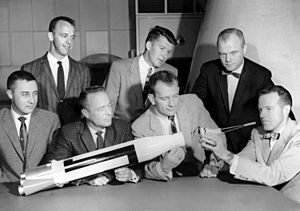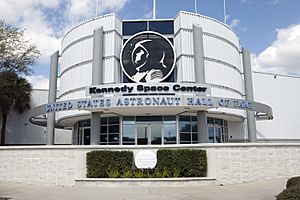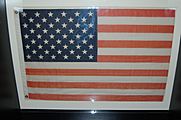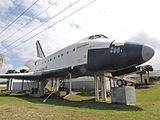United States Astronaut Hall of Fame facts for kids
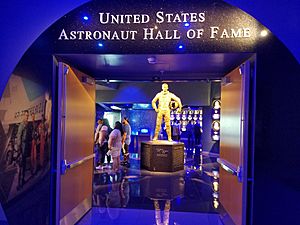
The United States Astronaut Hall of Fame is a special place in Merritt Island, Florida. It is part of the Kennedy Space Center Visitor Complex. This Hall of Fame celebrates amazing American astronauts. It has the world's largest collection of items from these space heroes. You can see things like Wally Schirra's Sigma 7 space capsule. This capsule flew on the fifth crewed Mercury mission. You can also see the Gemini IX spacecraft flown by Gene Cernan and Thomas P. Stafford in 1966.
Contents
History of the Hall of Fame
In the 1980s, some of the first American astronauts had a great idea. They were the Mercury Seven astronauts. They wanted a place to remember and honor US space travelers. It would be like other halls of fame for sports or music. So, the Mercury Seven Foundation was created. This foundation helps run the Hall of Fame today.
The Astronaut Hall of Fame first opened on October 29, 1990. It was next to the Florida branch of Space Camp.
The Hall of Fame moved in 2015. It closed its original location on November 2, 2015. It then moved to the main Kennedy Space Center Visitor Complex. This new location is about 6 miles (9.7 km) away. At the old building, there was a full-size model of a Space Shuttle. It was called Inspiration. This model was a static display outside. After the Hall of Fame moved, Inspiration was put into storage. It was later prepared for an educational tour.
The old Hall of Fame building was bought by Delaware North. It was renamed the ATX Center. For a while, it held educational programs. These included Camp Kennedy Space Center. They also had the Astronaut Training Experience. These programs later moved to the KSC Visitor Complex. In July 2020, Lockheed Martin announced it would use the building. They use it to support work on the NASA Orion crew capsule.
Astronauts Honored in the Hall
Astronauts are chosen for the Hall of Fame by a special committee. This group includes former NASA officials and space experts. They pick astronauts based on their achievements in space. They also look at their contributions to space exploration. Inductions have happened almost every year since 2001.
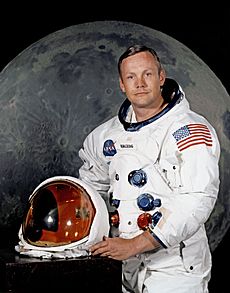
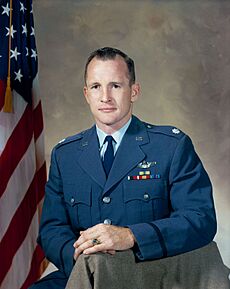
The first group of astronauts was honored in 1990. These were the original Mercury Seven astronauts. They were the first Americans in space. They also set many "firsts" for American spaceflight. Alan Shepard was the first American in space. He later walked on the Moon. John Glenn was the first American to orbit the Earth. In 1998, he became the oldest person to fly in space at age 77. Gus Grissom was the first American to fly in space twice. He was also the commander of the Apollo 1 mission. This mission had a tragic accident during training.

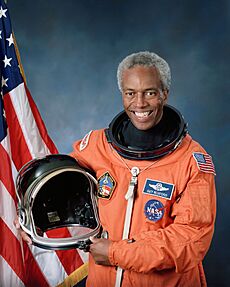
In 1993, thirteen more astronauts were inducted. These were from the Gemini and Apollo programs. This group included Neil Armstrong, the first person to walk on the Moon. It also included Eugene Cernan, the last person to walk on the Moon. Ed White was also in this group. He was the first American to walk in space. Jim Lovell commanded the famous Apollo 13 mission. John Young flew six times. He walked on the Moon and commanded the first Space Shuttle mission.
The third group was inducted in 1997. It included 24 more Apollo, Skylab, and ASTP astronauts. Roger Chaffee was one of them. He was an astronaut who died in the Apollo 1 accident. He was the only astronaut in the Hall who had not flown in space yet. Harrison Schmitt was the first scientist to walk on the Moon.
At first, all astronauts from the early programs were included. This meant Mercury, Gemini, Apollo, Skylab, and Apollo-Soyuz Test Project. But it would be too much to induct every astronaut who ever flew. So, for astronauts from the Space Shuttle program and later, they are chosen based on their special achievements. They are picked for their important contributions to human spaceflight.
Over 40 astronauts from the Space Shuttle program have been inducted since 2001. Sally Ride was inducted in 2003. She was the first American woman in space. Story Musgrave flew six missions. Francis Scobee was the commander of the final Challenger mission.
Recent inductees include Guion Bluford Jr. (2010), the first African American in space. Kathryn C. Thornton (2010) was also inducted. Susan Helms (2011) and Franklin Chang-Diaz (2012) were also honored. Eileen Collins (2013) was the first female Space Shuttle pilot and commander. Shannon Lucid (2014) and Jerry Ross (2014) were also inducted.
In 2015, John Grunsfeld and Steven Lindsey were inducted. Brian Duffy and Scott E. Parazynski joined in 2016. Ellen Ochoa and Michael Foale were inducted in 2017. Scott Altman and Thomas Jones followed in 2018. The 2019 inductees were James Buchli and Janet L. Kavandi.
Michael López-Alegría, Scott Kelly, and Pamela Melroy were inducted in 2021. The 2022 inductees were Christopher Ferguson, David Leestma, and Sandra Magnus. Roy Bridges Jr. and Mark Kelly were inducted in 2023. The 2024 inductees were David C. Hilmers and Marsha Ivins. Bernard A. Harris Jr. and Peggy Whitson were inducted in 2025.
What You Can See: Exhibits
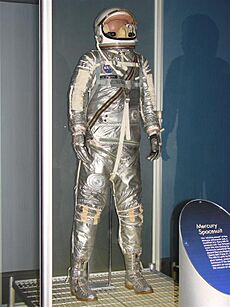

The Hall of Heroes has special tributes to all the astronauts. You can see the Sigma 7 Mercury spacecraft. Wally Schirra flew this spacecraft around Earth six times in 1962. You can also see the Gemini 9A capsule. Gene Cernan and Thomas P. Stafford flew it in 1966. There is also an Astronaut Adventure room. It has simulators for kids to try out.
You can also see the spacesuit worn by Gus Grissom. He wore it during his 1961 Liberty Bell 7 Mercury flight. This spacesuit has been part of a discussion between NASA and Grissom's family. The family loaned the spacesuit to the Hall of Fame when it first opened. After the Hall of Fame changed owners, the family asked for their items back. Most items were returned, but not the spacesuit. Both NASA and the Grissom family believe they own it.
Gallery
-
Alan Shepard's Apollo 14 lunar space suit
-
Replica of Apollo 15 Genesis Rock
See also

- Kennedy Space Center Visitor Complex
- List of astronauts by year of selection for training
- Space Mirror Memorial
- US Space Walk of Fame
- International Space Hall of Fame
- List of aerospace museums
- North American aviation halls of fame


